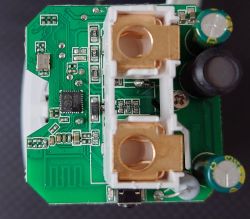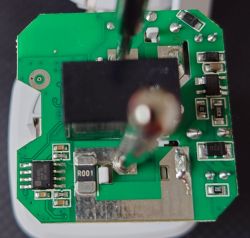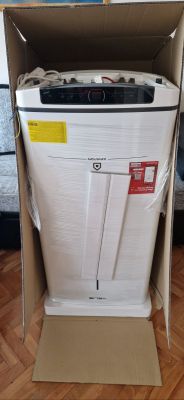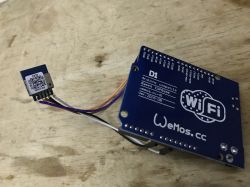Following the LSPA9 thread I ordered the following from AliExpress in December 2024:
"Tuya European Graffiti Wifi Smart Mobile Phone Timing Remote Voice Control with Electricity Socket Plug" from ATODUL Store (Store no: 1103832298)
Price when I ordered was 58 SEK (~5.10€) with AliExpress Choice. Screenshot below is from today with a higher price.

I forgot to take photos of the packaging before discarding. It was basically the same as what is pictured in the LSPA9 thread.
I found an easier method to open, as there is not much glue holding this together. I put the plug sideways onto a carpet to protect the surface underneath, and hit each side with a rubber mallet. After hitting each side with moderate force, the top came off easily, without any visible damage anywhere.
There is no text or any markings (CE, model number, voltage/current rating, etc) on the outside of the plug.
Inside I expected something similar to the LSPA9, but the plug has no module in it. The BK7231N chip is directly mounted to the main PCB. Tear down photos:


Removing the PCB requires only one Philips screw, located near the middle. Push up from the bottom to remove the PCB with the metal contacts. The plug is using the Fanhar FH17-1A2TLE relay.
Flashing was easy, as the UART Tx/Rx, 3.3V, and GND are all available at testpoints:

After some tracing and continuity testing with the DMM, here is the observed pin configuration:
Apologies for any mistakes, this is my first time posting. Let me know if the photos are too low resolution and I will try to provide better quality, or if anything else should be improved.
"Tuya European Graffiti Wifi Smart Mobile Phone Timing Remote Voice Control with Electricity Socket Plug" from ATODUL Store (Store no: 1103832298)
Price when I ordered was 58 SEK (~5.10€) with AliExpress Choice. Screenshot below is from today with a higher price.

I forgot to take photos of the packaging before discarding. It was basically the same as what is pictured in the LSPA9 thread.
I found an easier method to open, as there is not much glue holding this together. I put the plug sideways onto a carpet to protect the surface underneath, and hit each side with a rubber mallet. After hitting each side with moderate force, the top came off easily, without any visible damage anywhere.
There is no text or any markings (CE, model number, voltage/current rating, etc) on the outside of the plug.
Inside I expected something similar to the LSPA9, but the plug has no module in it. The BK7231N chip is directly mounted to the main PCB. Tear down photos:


Removing the PCB requires only one Philips screw, located near the middle. Push up from the bottom to remove the PCB with the metal contacts. The plug is using the Fanhar FH17-1A2TLE relay.
Flashing was easy, as the UART Tx/Rx, 3.3V, and GND are all available at testpoints:

After some tracing and continuity testing with the DMM, here is the observed pin configuration:
Code: JSON
Apologies for any mistakes, this is my first time posting. Let me know if the photos are too low resolution and I will try to provide better quality, or if anything else should be improved.






![[BK7231N/BL0937] Teardown Generic 20A EU Wifi Smart Plug with Energy Measurement [BK7231N/BL0937] Teardown Generic 20A EU Wifi Smart Plug with Energy Measurement](https://static.elektroda.pl/attach/thumb/1736882386130_1650429.jpg)
![[BK7231N/BL0937] Teardown Generic 20A EU Wifi Smart Plug with Energy Measurement [BK7231N/BL0937] Teardown Generic 20A EU Wifi Smart Plug with Energy Measurement](https://static.elektroda.pl/attach/thumb/1736882386078_1294428.jpg)
![[BK7231N/BL0937] Teardown Generic 20A EU Wifi Smart Plug with Energy Measurement [BK7231N/BL0937] Teardown Generic 20A EU Wifi Smart Plug with Energy Measurement](https://static.elektroda.pl/attach/thumb/1736882386053_1519576.jpg)
![[BK7231N/BL0937] Teardown Generic 20A EU Wifi Smart Plug with Energy Measurement [BK7231N/BL0937] Teardown Generic 20A EU Wifi Smart Plug with Energy Measurement](https://static.elektroda.pl/attach/thumb/1736882386104_1227498.jpg)
![[BK7231N/BL0937] Teardown Generic 20A EU Wifi Smart Plug with Energy Measurement [BK7231N/BL0937] Teardown Generic 20A EU Wifi Smart Plug with Energy Measurement](https://static.elektroda.pl/attach/thumb/1736882385946_9430604.jpg)
![[BK7231N/BL0937] Teardown Generic 20A EU Wifi Smart Plug with Energy Measurement [BK7231N/BL0937] Teardown Generic 20A EU Wifi Smart Plug with Energy Measurement](https://static.elektroda.pl/attach/thumb/1736882386182_1000257.jpg)
![[BK7231N/BL0937] Teardown Generic 20A EU Wifi Smart Plug with Energy Measurement [BK7231N/BL0937] Teardown Generic 20A EU Wifi Smart Plug with Energy Measurement](https://static.elektroda.pl/attach/thumb/1736882386024_1285021.jpg)
![[BK7231N/BL0937] Teardown Generic 20A EU Wifi Smart Plug with Energy Measurement [BK7231N/BL0937] Teardown Generic 20A EU Wifi Smart Plug with Energy Measurement](https://static.elektroda.pl/attach/thumb/1736882385998_1241477.jpg)
![[BK7231N/BL0937] Teardown Generic 20A EU Wifi Smart Plug with Energy Measurement [BK7231N/BL0937] Teardown Generic 20A EU Wifi Smart Plug with Energy Measurement](https://static.elektroda.pl/attach/thumb/1736882386260_7083565.jpg)
![[BK7231N/BL0937] Teardown Generic 20A EU Wifi Smart Plug with Energy Measurement [BK7231N/BL0937] Teardown Generic 20A EU Wifi Smart Plug with Energy Measurement](https://static.elektroda.pl/attach/thumb/1736882386207_1885376.jpg)
![[BK7231N/BL0937] Teardown Generic 20A EU Wifi Smart Plug with Energy Measurement [BK7231N/BL0937] Teardown Generic 20A EU Wifi Smart Plug with Energy Measurement](https://static.elektroda.pl/attach/thumb/1737192835308_1369683.jpg)
![[BK7231N/BL0937] Teardown Generic 20A EU Wifi Smart Plug with Energy Measurement [BK7231N/BL0937] Teardown Generic 20A EU Wifi Smart Plug with Energy Measurement](https://static.elektroda.pl/attach/thumb/1737192835271_2097186.jpg)